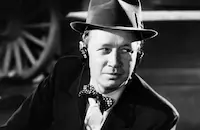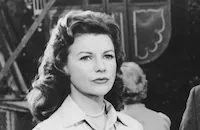The Bamboo Blonde

Brief Synopsis
Cast & Crew
Anthony Mann
Frances Langford
Ralph Edwards
Russell Wade
Iris Adrian
Richard Martin
Film Details
Technical Specs

Synopsis
Magazine writer Montgomery interviews Eddie Clark, the head of the highly successful Bamboo Blonde company, and questions him about the company's beginnings. The enthusiastic Eddie relates the following story: A few years earlier, just before he is about to be shipped out, new recruit Lieutenant Patrick Ransom, Jr. is sent to Eddie's "off-limits" New York nightclub by his mischievous bomber plane crew. While hiding from the military police, Pat, the son of a wealthy Pennsylvanian, meets singer Louise Anderson and ends up dining with her. Although he is officially engaged to socialite Eileen Sawyer, a snob who has stood him up, Pat is attracted to down-to-earth Louise. Unaware that Pat is rich, Louise insists on paying his way and accompanies him to the airport. Before he and his South Pacific-bound crew board their airplane, Pat playfully demands that Louise take an instant photograph of herself and keeps it as a memento. In Saipan, Pat is kidded by his crew about his "girl friend," but is too embarrassed to admit that he doesn't know her name and plays the role of the silent Lothario. When the usually effective crew then fails to down any enemy planes, they decide to use Louise's photograph as a good-luck charm by painting her likeness on the side of their airplane. The crew's subsequent success in battle draws attention to the portrait, which has been dubbed the "Bamboo Blonde," and back in New York, the ambitious Eddie begins promoting Louise as the real Bamboo Blonde. Although at first hesitant to exploit the situation, Louise eventually goes along with Eddie's plans. Soon, however, Pat and his crew are ordered back to New York to begin a war bond promotion tour. While both Pat and Louise fret about their impending reunion, which is being covered by the press as a national event, Eileen decides to reclaim Pat as her fiancé. After Eileen makes her presence known to Louise at the airport, the chagrined Pat asks the equally embarrassed Louise to continue the "ruse" for the sake of the tour. Depressed by Pat's apparent indifference, Louise seeks comfort at her favorite restaurant. To her delight, Pat soon joins her and reassures her that he is no longer engaged and would like to romance her in earnest. The next night, however, Eileen confronts Louise and tells her she is too low-class for Pat. Eileen then threatens to expose Pat as a cad by announcing their engagement during the bond tour. Although Louise agrees to accompany Pat and the crew on the tour, she avoids Pat out of fear of Eileen. Eventually, however, Pat forces Louise to admit she loves him, and the couple become engaged. When Eileen reads about the engagement, she decides to hold a Bamboo Blonde bond party at her estate. During the party, Louise learns that Pat's parents will not be attending and assumes that they are rejecting her because of her class. Hurt, Louise leaves, but is intercepted at the airport by Pat, who insists on flying her back to New York himself. While flying in a thick fog, Pat pretends to be lost and lands the plane in his own backyard. As Louise eavesdrops outside the Ransoms' front window, Pat's parents inform their son that Eileen never told them about the party. Confident at last that Pat truly loves her, Louise happily reunites with her pilot.

Director

Anthony Mann
Cast

Frances Langford
Ralph Edwards

Russell Wade

Iris Adrian

Richard Martin

Jane Greer

Glenn Vernon

Paul Harvey
Regina Wallace

Jean Brooks

Tom Noonan
Dorothy Vaughan
Larry Wheat

Eddie Acuff
Steve Barclay
Jimmy Jordan
Robert Manning
Robert Clarke
Al Martini
Don Evers
James Leahy
Bruce Edwards
Paul Brooks
Betty Gillette
Harry Harvey
Mary Worth
Alexander Pollard
Frances Ring
Don Davis
Carl Hanson
Jack Arkin

Nan Leslie
Bob Randall
Lew Short
Eric Mayne
Herbert Evans
Foster Phinney

Walter Reed
Vonne Lester
Lee Elson
Dennis Waters
Bonnie Blair
Jean Andren
Crew
C. Bakaleinikoff
James Casey
Olive Cooper
Lucius Croxton
Albert S. D'agostino
Mort Greene
Robert Keith
Lawrence Kimble
Allen Martini Major, U.s. Army Air Force
Les Millbrook
Earl B. Mounce
Charles O'curran
Lew Pollack
Frank Redman
Renie
Sid Rogell
Herman Schlom
Darrell Silvera
Jean L. Speak
Leslie Urbach
Vernon L. Walker

Film Details
Technical Specs

Articles
The Bamboo Blonde
Some have noted, however, a refreshing down-to-earth quality in The Bamboo Blonde, thanks largely to its low budget. Lack of funds meant no luxury for the sort of over-designed and unrealistic sets and costumes on hand in the big productions, offering instead "ordinary" characters in ordinary settings without the trappings of high glamour.
The story features Langford as a smalltime nightclub singer who falls for a pilot shipping out to the Pacific. On Saipan, his crew paints her picture on the nose of their plane and christens it "The Bamboo Blonde." The club's owner sees the chance to exploit the success of their wartime missions by advertising the real Bamboo Blonde as his singer and developing a line of products to capitalize on her new fame.
This was Langford's return to stateside show business after a few years entertaining the wartime troops, primarily in the company of Bob Hope. Reviewers noted rather unkindly that the time on the frontlines seemed to have taken its toll on her appearance. A cute, round-faced blonde but never a great beauty, Langford's great appeal had been what was often described as her honey voice, first made popular through extensive radio fame and later in a string of B-pictures. Perhaps to mitigate criticism of the star's looks, many reviewers put the blame on cinematographer Frank Redman, who had apparently done better by Langford in her earlier musical Too Many Girls (1940).
The songs Langford performs here were hardly up to the standards of her hits "I'm in the Mood for Love" or "You Are My Lucky Star," and reviewers at that time noted that only one, "Dreaming Out Loud," had even the slightest chance of outliving the picture. They were written by Mort Greene and Lew Pollack, who individually and together created tunes for several B-pictures, often uncredited, as they are on this movie. Greene, however, made an indelible cultural impression years later with his theme song for the TV series Leave It to Beaver. Pollack died of a heart attack at age 51 only a few months before The Bamboo Blonde was released.
The nightclub owner is played by Ralph Edwards, another popular radio personality who made the transition to film in the 1940s. Like Langford, Edwards only made a handful of pictures, none of them particularly distinguished, while keeping up his busy broadcast career. He later created and hosted the successful 1950s TV series This Is Your Life, in which celebrities, apparently caught unaware, were whisked off to a studio to be present for an on-air biography. Edwards later created and produced the popular TV show The People's Court.
Also featured in the cast is Jane Greer (cast as the male lead's snooty rich fiancée) in one of her earliest roles. She got her biggest break a year later as a prototypical film noir femme fatale opposite Robert Mitchum in Out of the Past (1947). Subsequent projects boded well for a long and successful career, but Greer put a higher priority on her family and private life for many years and made relatively few films.
Director: Anthony Mann
Producer: Herman Schlom
Screenplay: Olive Cooper, Lawrence Kimble, based on a story by Wayne Whittaker
Cinematography: Frank Redman
Editing: Les Millbrook
Art Direction: Albert S. D'Agostino, Lucius Croxton
Original Music: Mort Greene, Lew Pollack (songs, uncredited)
Cast: Frances Langford (Louise Anderson), Ralph Edwards (Eddie Clark), Russell Wade (Patrick Ransom), Iris Adrian (Montana), Jane Greer (Eileen Sawyer).
BW-67m.
by Rob Nixon

The Bamboo Blonde
Quotes
Trivia
Notes
The working title of this film was Chicago Lulu. According to a December 1943 Hollywood Reporter news item, George Sanders was first slated to star in the production. Although some reviewers noted that The Bamboo Blonde marked Frances Langford's return to the screen after a long overseas tour, she had actually appeared in RKO's late 1945 picture Radio Stars on Parade (see below). In addition, the Hollywood Reporter review referred to popular radio host Ralph Edwards' performance as a film debut, but his first screen role was in the 1937 picture Manhattan Merry-Go-Round. Some Hollywood Reporter production charts list Charles F. Pyke as art director, but his participation in the final film has not been confirmed.

Miscellaneous Notes
Released in United States Summer July 15, 1946
Released in United States Summer July 15, 1946













